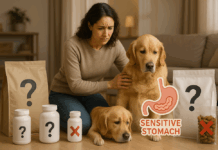Last Updated on May 17, 2024 by Dogs Vets
The Benefits of Grain-Free and Raw Diets for Your Canine Companion
Keeping your dog healthy: The world of natural dog nutrition is gaining popularity as more and more pet owners are becoming aware of the importance of providing their canine companions with a healthy and balanced diet.
This article will explore the benefits of grain-free and raw diets for dogs, as well as providing guidance on how to transition your dog to a natural diet, popular brands, and potential risks and considerations.
Grain-Free Dog Diets
A grain-free dog diet is one that eliminates grains such as wheat, corn, rice, and barley from your dog’s food. This type of diet is designed to more closely mimic the ancestral diet of canines, which were primarily meat-eaters.
Why Choose a Grain-Free Diet?
Many pet owners have found that grain-free diets provide the following benefits:
- Reduced Allergies: Some dogs are allergic or intolerant to grains, causing skin irritations, digestive issues, and other health problems. By eliminating grains, these issues may be resolved.
- Improved Digestion: Grains are harder for dogs to digest than proteins and fats, so a grain-free diet can lead to improved digestion and nutrient absorption.
- Higher Protein Content: Grain-free diets often contain higher levels of protein, which supports muscle development, a healthy immune system, and overall well-being.
- Increased Energy Levels: Dogs on grain-free diets often experience increased energy levels, as their bodies are better equipped to process proteins and fats for energy.
- Healthier Skin and Coat: A grain-free diet, rich in essential fatty acids, can lead to a healthier skin and coat for your dog.
Raw Dog Diets
A raw dog diet, also known as a biologically appropriate raw food (BARF) diet, consists of feeding your dog raw, unprocessed meats, bones, fruits, and vegetables. This type of diet aims to replicate the natural, evolutionary diet of wild canines.
Components of a Raw Dog Diet
A well-balanced raw dog diet typically includes:
- Muscle Meat: The primary source of protein in a raw diet, which can include poultry, beef, lamb, or fish.
- Organs: Liver, kidney, and other organ meats provide essential nutrients and vitamins.
- Bones: Raw bones provide calcium, phosphorus, and other minerals essential for strong bones and teeth.
- Fruits and Vegetables: A variety of fruits and vegetables provide essential vitamins, minerals, and antioxidants for optimal health.
- Eggs and Dairy: Eggs and dairy products, such as yogurt and cottage cheese, can be included in moderation to provide additional protein, vitamins, and minerals.
- Nutra Complete: Some dog owners choose to supplement their pet’s raw diet with products like Nutra Complete, which is specifically formulated to provide a comprehensive balance of essential nutrients, including vitamins, minerals, and omega-3 fatty acids. Adding Nutra Complete in appropriate amounts can help ensure that your dog receives all the necessary nutrients for their overall well-being.
Advantages of a Raw Dog Diet
Feeding your dog a raw diet can offer numerous benefits, such as:
- Improved Digestion: Raw diets are easier for dogs to digest, resulting in better nutrient absorption and fewer digestive issues.
- Healthier Skin and Coat: Raw diets are rich in essential fatty acids, which contribute to a shiny, healthy coat and reduced skin irritations.
- Stronger Immune System: A balanced raw diet can help boost your dog’s immune system, making them less susceptible to illnesses and infections.
- Increased Energy Levels: Dogs on raw diets often exhibit higher energy levels and improved overall vitality.
- Better Dental Health: Chewing on raw bones can help keep your dog’s teeth clean, reducing plaque buildup and the risk of dental problems.
Benefits of Grain-Free and Raw Diets
Both grain-free and raw diets offer a range of advantages for your canine companion. By providing your dog with a natural, high-quality diet, you are promoting their overall health and well-being. The benefits of these diets include:
- Enhanced digestion and nutrient absorption
- Reduced risk of food allergies and intolerances
- Increased energy levels
- Healthier skin and coat
- Improved immune system function
- Better dental health
How to Transition Your Dog to a Natural Diet
Transitioning your dog to a grain-free or raw diet should be done gradually to avoid digestive issues.
Here are some steps to follow:
- Consult Your Veterinarian: Before making any changes to your dog’s diet, it’s essential to consult with a veterinarian or canine nutritionist to ensure the new diet meets your dog’s specific needs.
- Introduce the New Diet Slowly: Begin by replacing a small portion of your dog’s current food with the new grain-free or raw diet. Gradually increase the amount of new food while decreasing the old food over a period of 7-10 days.
- Monitor Your Dog’s Health: Keep an eye on your dog’s weight, energy levels, and overall health during the transition. If any issues arise, consult your veterinarian for guidance.
Popular Grain-Free and Raw Dog Food Brands
There are numerous brands on the market that offer grain-free and raw dog food options. Some of the top brands include:
- Orijen: A leading grain-free brand, Orijen offers a variety of high-protein, low-carbohydrate recipes for all life stages.
- Taste of the Wild: This brand offers grain-free recipes inspired by the ancestral diet of wild canines, with a focus on high-quality, natural ingredients.
- Stella & Chewy’s: This brand specializes in raw, freeze-dried, and frozen dog food options, providing a wide range of recipes to suit your dog’s preferences and dietary needs.
Home-Prepared Natural Dog Diets
For those who prefer to prepare their dog’s food at home, it’s essential to ensure a balanced and complete diet. Consult with a veterinarian or canine nutritionist to develop a suitable meal plan that meets your dog’s specific needs.
Key components of a home-prepared natural dog diet include:
- High-Quality Protein Sources: Choose a variety of protein sources, such as poultry, beef, lamb, or fish, to ensure a balanced amino acid profile.
- Essential Fatty Acids: Include sources of omega-3 and omega-6 fatty acids, such as fish oil or flaxseed oil, for optimal skin and coat health.
- Vitamins and Minerals: Supplement your dog’s diet with essential vitamins and minerals to support overall health and well-being. This can be achieved through a combination of fruits, vegetables, and appropriate supplements.
- Calcium and Phosphorus: Ensure that your dog receives adequate amounts of calcium and phosphorus for strong bones and teeth. This can be provided through raw bones, ground eggshells, or supplements.
- Monitor Nutritional Balance: Regularly consult with your veterinarian or canine nutritionist to ensure your home-prepared diet remains balanced and meets your dog’s changing needs.
Potential Risks and Considerations
While grain-free and raw diets can offer numerous benefits, it’s essential to be aware of potential risks and considerations, such as:
- Nutritional Imbalances: A poorly formulated grain-free or raw diet can lead to nutritional imbalances, which can negatively impact your dog’s health. Always consult with a veterinarian or canine nutritionist when developing a diet plan.
- Bacterial Contamination: Raw diets carry a risk of bacterial contamination, both for your dog and your household. Practice proper food handling and hygiene to minimize this risk.
- Choking Hazards: Feeding your dog whole raw bones can pose a choking hazard or cause injury if the bones splinter. Always supervise your dog when feeding bones, and choose appropriate bone sizes and types for your dog’s breed and size.
- Cost and Time Commitment: Grain-free and raw diets can be more expensive and time-consuming to prepare than traditional kibble. Consider your budget and schedule when deciding on a natural diet for your dog.
Consulting a Veterinarian or Canine Nutritionist
Before making any significant changes to your dog’s diet, it’s essential to consult with a veterinarian or canine nutritionist.
They can help you develop a balanced and complete diet plan that meets your dog’s specific needs and address any health concerns or dietary restrictions.
Conclusion
Grain-free and raw diets offer numerous benefits for your canine companion, from improved digestion and nutrient absorption to increased energy levels and overall well-being.
By providing your dog with a natural, high-quality diet, you are promoting their long-term health and happiness.
Always consult with a veterinarian or canine nutritionist before making any changes to your dog’s diet and monitor their health throughout the transition process.
Frequently Asked Questions
Are grain-free and raw diets suitable for all dogs?
While many dogs can thrive on grain-free and raw diets, it’s essential to consult with a veterinarian or canine nutritionist to determine if these diets are appropriate for your dog’s specific needs and health conditions.
Can puppies be fed grain-free or raw diets?
Yes, puppies can be fed grain-free or raw diets, but it’s crucial to ensure the diet is properly balanced and meets their specific nutritional requirements for healthy growth and development. Consult with a veterinarian or canine nutritionist for guidance.
How can I ensure my dog’s grain-free or raw diet is nutritionally balanced?
Consulting with a veterinarian or canine nutritionist can help ensure that your dog’s diet is balanced and meets their specific nutritional needs.
Regular checkups and blood tests can also help monitor your dog’s health and identify any potential deficiencies.
Can a grain-free or raw diet help my dog lose weight?
A grain-free or raw diet may help some dogs lose weight due to its higher protein and lower carbohydrate content.
However, weight loss ultimately depends on caloric intake and energy expenditure. Consult with a veterinarian for personalized advice on your dog’s weight management.
Do grain-free and raw diets prevent or cure specific health conditions?
While some health conditions may improve with a grain-free or raw diet, there is no guarantee that these diets will prevent or cure all health issues.
Always consult with a veterinarian before making dietary changes to address specific health concerns.
How do I safely store raw dog food?
Raw dog food should be stored in the refrigerator or freezer to minimize bacterial growth. Ensure that the food is properly sealed in airtight containers and kept separate from human food to prevent cross-contamination.
Can I mix kibble with raw food in my dog’s diet?
While it is possible to mix kibble and raw food, it’s important to be aware that these foods have different digestion rates, which may cause digestive issues for some dogs.
Consult with a veterinarian or canine nutritionist for guidance on combining these foods in a balanced and safe manner.
Fact Check
We hope you enjoyed reading this article. What are your thoughts on the topic?
“At [Dogsvets.com], our goal is to bring you the most accurate and up-to-date information on all things pet-related.
If you have any additional insights or would like to advertise with us, don’t hesitate to get in touch.
If you notice any errors or discrepancies in our content, please let us know so we can correct them.
We welcome your feedback and encourage you to share this article with others.”

















